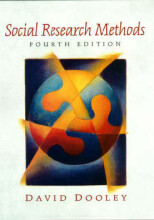Summary: Social Research Methods | 9780139554285 | David Dooley
- This + 400k other summaries
- A unique study and practice tool
- Never study anything twice again
- Get the grades you hope for
- 100% sure, 100% understanding
Read the summary and the most important questions on Social research methods | 9780139554285 | David Dooley.
-
4 Theory tentative explanations
This is a preview. There are 6 more flashcards available for chapter 4
Show more cards here -
Theories serve us in two major ways. Name them:
1. Theories meet our need to act even when we are uncertain.
2. Theories prove useful by guiding research.
-
5 Measurement Theory: Toward Validity and reliability
This is a preview. There are 23 more flashcards available for chapter 5
Show more cards here -
How do you call errors arising between two test situations?
Between-occasion error.
-
Name the three methods of assessing reliability that take into account between-occasion error or between-rater error:
Test-Retest reliability, parallel test reliability, interrater reliability.
-
Name the four facets of measurement:
Occasion, rater, item, and form.
-
How can you make measures more reliable?
Substituting more reliable items for less reliable ones and adding more items of the same reliability (cause that is giving more the chance of random error to cancel).
-
What kinds of variables might intrude into social science measures with unwatend W score components?
Response styles and response sets.
-
Criterion has a number of variants. If we measure with the new test before the criterion, we call the method...
predictive validity
-
6 Types of measures
This is a preview. There are 20 more flashcards available for chapter 6
Show more cards here -
Which two important dimensions will organize this treatment of quantitative measures?
Verbal versus nonverbal measurement and obtrusive versus unobtrusive measurement
-
The interview can be placed in 3 out of 4 types of measurements. In which type of measurement it doesn't belong?
nonverbal, unobtrusive category
-
What is the advantage of a projective test compared to other self tests?
Its relative nonreactive. (The subject, unless well read in projective testing, cannot infer what answers will produce the desired impression.)
- Higher grades + faster learning
- Never study anything twice
- 100% sure, 100% understanding
































